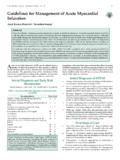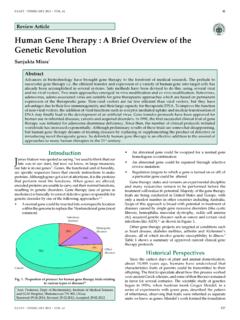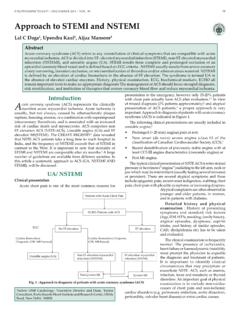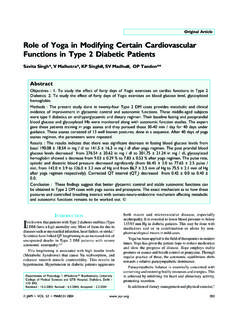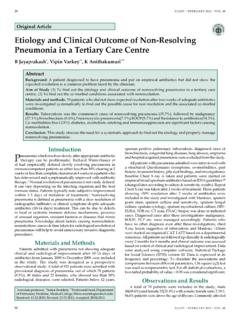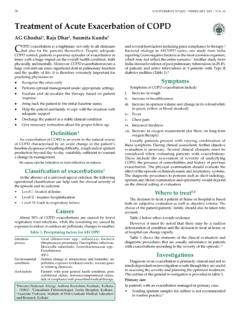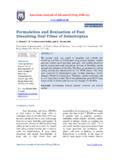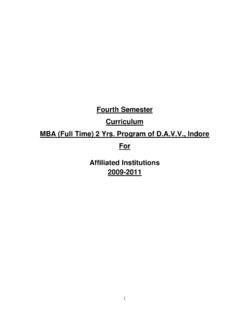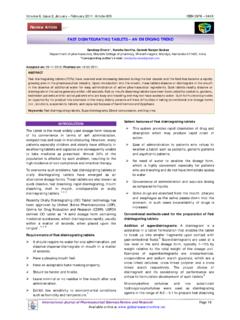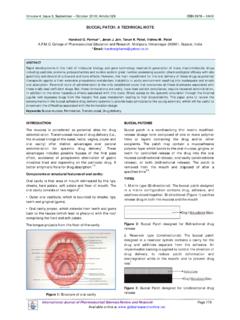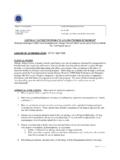Transcription of Tolperisone - japi.org
1 JAPI FebruAry 2010 VOL. 58 127 Tolperisone , a centrally acting muscle relaxant agent, which has been in therapeutic use for more than three decades, has been widely used as spasmolytics of choice. It is recently launched drug in India for acute and chronic back pain and spasticity of neurological origin. To l p e r i s o n e i s a n a r y l a l k y l - a m i n o k e t o n e h av i n g a n asymmetric carbon atom to the carbonyl group. It has higher muscle relaxant activity than the dextrorotatory enantiomer. It exhibits membrane stabilizing potency, which is characteristic of anti arrythmic and local anesthetic differs from other myotonolytic agents in its pharmacological properties, which mediate muscle relaxation without concomitant sedation1 or withdrawal of actionbeing, centrally acting muscle relaxant, Tolperisone acts at the level of spinal cord by blocking sodium channels and calcium channels.
2 Tolperisone exerts its spinal reflex inhibitory action predominantly via a pre synaptic inhibition of the transmitter release from the primary afferent endings via a combined action on voltage-gated sodium and calcium increases the blood supply to skeletal muscles; this ac tion is notewor thy since a muscle contrac ture may compress the small blood vessels and induce an ischemia leading to release of pain stimulating causes preferential antinociceptive ac tivit y against thermal stimulation that is likely to be attributed to its local anesthetic causes muscle relaxation by its action on central nervous system. It also leads to membrane stabilization & has analgesic activity.
3 This muscle relaxation is dose : Tolperisone gets absorbed quickly in the body and peak plasma concentration is achieved usually h after oral ingestion. The Cmax is between ng/ml and Tmax is Absolute bio -availability is approximately 17% due to hepatic first-pass effect. Tolperisone undergoes both P450- dependent and P450-independent microsomal biotransformations5. It is eliminated from the body primarily through the k idneys - 85% and 98% of the given dose is eliminated in the urine after 8 hours and 24 hours respectively. elimination half-life of Tolperisone HCl is between - can be administered through various routes (oral, intra-ar ter ial, intrathecal, intraspinal, intramuscular, i n t r a p e r i t o n e a l , i n t r a v e n o u s , i n t r a n a s a l a n d i n h a l a t i o n ).
4 However, intramuscular, intravenous and oral are preferred routes of administration. Therapeutically effective dosage of Asst. Hon. & In Charge, Dept. of Chest & Tb, Dr. Cooper Muni. Gen. Hospital, Mumbai; Asst Prof., Dept. of Chest & Tb, K J Somaiya M e d i c a l Co l l e g e, M u m b a i ; A s s t e d i t o r, J o u r n a l o f A s s o c i a t i o n Physician of India; President elect, Malad Medical Associationtolperisone ranges from approximately 75 to 1500 profile of Tolperisone varies from individual to individual. There is a need for individualization of dosage of Tolperisone while administering the therapy to the InteractionsNo drug interac tions of Tolperisone hydrochloride have been reported with the concomitant intake of benzodiazepines, non-steroidal anti-inflammator y drugs (NSAIDs), analgesics and Low back pain syndrome6 Painful reflex muscle spasm7 Post-cerebral stroke spasticity 8 Neurolathyrism9 Trapezitis rehabilitation programmes PeriarthritisPrecaution and ContraindicationTolperisone hydrochloride tablets are contraindicated in patients who are hypersensitive to any of the ingredients of the formulation.
5 Tolperisone is contraindicated in patients suffering from myasthenia gravies and in patients. Since, no well-controlled studies have been carried out with the drug in pregnant and lactating women; Tolperisone should be used with caution in such patients keeping the risk-benefit ratio of the effectsIt may cause excessive sweating, urticaria or erythema. Also may lead to GI upset with abdominal paon, nausea, vomiting, diarrhea, flatulence or dryness of recommendationsTherapeutic dose of Tolperisone varies with condition and can be determined empirically. Tolperisone dose will var y depending upon the age, weight and general condition of the individual and will also depend on the severity of the usually recommended dose of Tolperisone hydrochloride in adults is 50 mg tablet given three times a day ( a daily dose of 150 mg) that can be increased to a maximum daily dose of 600 mg if required.
6 In children, the drug is administered in a daily dose of 5-10 mg/kg/day, given in three divided doses. The dose of the drug should be reduced in the elderly and in patients with hepatic or renal insufficiency. The dosage of the drug should be maintained until the therapeutic effect is reached. Afterwards, the dosage of the drug should be reduced in TherapyIts good tolerability with minimum contraindications and Drug reviewTolperisoneAgam Vora128 JAPI FebruAry 2010 VOL. 58safety makes Tolperisone a suitable choice of muscle relaxant for a broad range of patients including elderly patients with concomitant diseases. references1. Dulin J, Kovacs L, ramm S, et al.
7 Evaluation of sedative effects of single and repeated doses of 50 mg and 150 mg Tolperisone hydrochloride. results of a prospective, randomized, double-blind, placebo-controlled trial. Pharmacopsychiatry. 1998;31:137 Pal K , Sandor F, Laszlo F, et al. Tolperisone -type drugs inhibit spinal reflexes voltage-gated sodium and calcium channels. JPeT. 2005;315:1237 Ak iko S, Motoko H, Mitsuo T, et al. Antinociceptive effec ts of sodium channel-blocking agents on acute pain in mice. J Pharmacol Sci. 2004;95:181 1884. bae JW, K im MJ, Par k yS, et al. Considerable inter individual variation in the pharmacokinetics of Tolperisone HCI. Int J Clin Pharmacol Therap. 2007;45:110 1135.
8 Balazs D, Janos L, Szabolcs S, et al. Identification of metabolic pathways involved in the biotransformation of Tolperisone by human microsomal enzymes. Drug Metab Dispos. 2003;31:631 6366. Chernysheva T V, bagirova GG. Midocalm in complex therapy of chronic low back pain syndrome. Klin Med (Mosk). 2005;83:45 497. Pratzel HG, Alken rG, ramm S. efficacy and tolerance of repeated oral doses of Tolperisone hydrochloride in the treatment of painful reflex muscle spasm: results of a prospective placebo-controlled double-blind trial. Pain. 1996;67:417 Stamenova P, Koytchev r, Kuhn K, et al. A randomized, double blind, placebo - controlled study of the efficac y and safet y of Tolperisone in spasticity following cerebral stroke.
9 Zh Nevrol Psikhiatr Im S S Korsakova. 2006;106:34 Melka A, Tekle Haimanot r, Lambien F. Symptomatic treatment of neurolathyrism with Tolperisone HCL (Mydocalm): A randomized double blind and placebo controlled drug trial. ethiop Med J. 1997;35:77 91.
